Nader Sabry's Blog, page 2
March 20, 2021
Growth thinking vs. Business Model Canvas
 Growth thinking vs. Business Model Canvas – an in-depth comparison
Growth thinking vs. Business Model Canvas – an in-depth comparisonGrowth thinking, like business model canvas, is both design methodology for problem-solving. Business model canvas is for building a company, whereas growth thinking is about accelerating growth.
Both serve an equally important role as they complement each other in several ways. They compliment each other, whereas business model canvas is about building and starting, and growth thinking is an accelerating growth methodology.
If you look at the spectrum of business methodologies, there are four types.
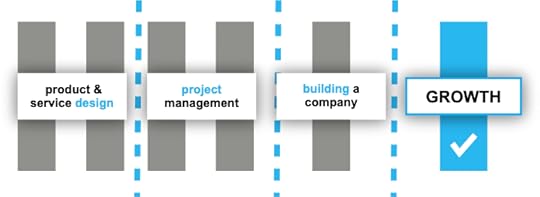 Accelerating growth
Accelerating growthHow to accelerate and manage exponential growth using growth thinking. Some examples of methods are:
Pirate Funnel AARRRG.R.O.W.S.-processT-shaped Growth HackerOne Metric That MattersNorth Star MetricBuild a companyHow to start a company from the beginning. Some examples of methods are:
The Business Model CanvasThe Value Proposition CanvasLean Startup CanvasBlitzscaling Canvas BusinessModel Innovation FrameworkManaging projectsHow to effectively implement and manage a product management model that works. Some examples of methods are:
AgileScrumWaterfallKanbanPRINCE2Offering DesignHow to optimize and manage product design using approaches like design thinking. Some examples of methods are:
Design ThinkingGoogle Design SprintsLean StartupDouble Diamond DesignKano ModelWhere do business model canvas and growth thinking connectThere are two perspectives to this; the first is if a new startup is beginning from scratch, and the second is if you are already operating a business regardless of size.
If you a startup — business model canvas becomes your business plan and blueprint for founders, investors, and other stakeholders, and growth thinking is where it helps accelerate those plans.
If you’re an operating business — growth thinking would supersede business model canvas as you would have your company ready to accelerate its growth.
Will business model canvas improve design thinkingIn short, no, they work in total isolation from each other, but they complement one another when combined in the right sequence—knowing which method to us when is an essential part of a leader’s and founder’s strategy.
Selecting the right methodology is about the following aspects:
Can it achieve what we needIs it easy to use and learnIs there enough supporting materialsCan it improve our ROIThose four factors help you choose the right method at the right time. Supporting materials and being able to learn the method are critical. The faster and easier you can adapt to a new method, the better it is. This factor would supersede inherent drawbacks, which they would all have.
It’s more important to learn quickly vs. inherited drawbacks because once you know the drawbacks, you can become even more creative with those methodologies. Many of the methodology designers focus on updates and upgrades over time.
Business model CanvasThe Business Model Canvas is a methodology to map and plan the various components of your business model. It is an effective way to bring together all strategy elements, from the initial costs to the customers’ revenue streams.
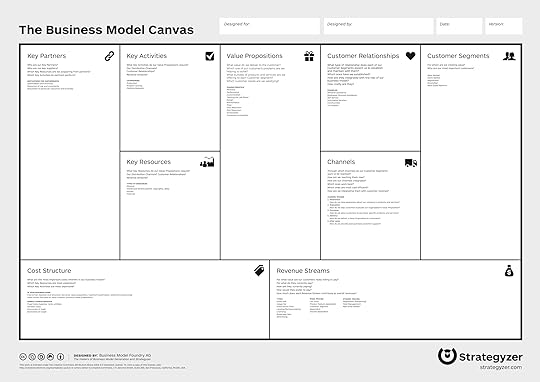
When the business model canvas is filled correctly, almost everyone can understand your business and its functions straightforwardly and intuitively.
Business plans vs. business model canvasWhile traditional business plans are cumbersome to read, a business model is a one-page document that addresses a startup’s core business objectives (most of which are launched), such as getting customers to pay. It beats the traditional business plan, including several pages, by offering a much easier way to understand your business’s various core elements in a single picture.
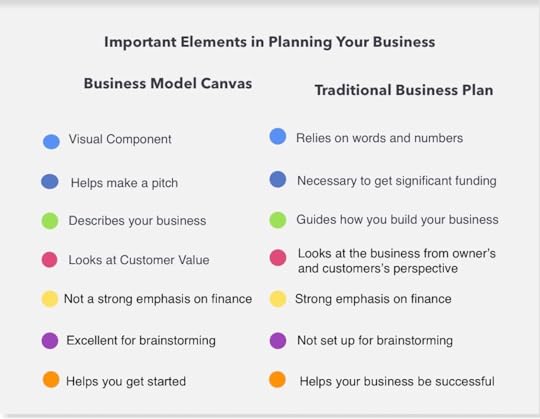
If you don’t delve deep into the concepts, it gives you an idea of what the business is and how it works. Business model screens are one of the most popular business models in the world today, and they can describe your business model straightforwardly and intuitively, unlike other methods that use visual descriptions.
Initially developed by Alex Osterwalder and Yves Pigneur, Business Model Canvases is a strategic management tool that enables you to visualize and evaluate your business ideas and concepts. They introduce you to the process of developing and testing your organization’s business model (s), according to the website.
Value Proposition CanvasJust like the business model canvas itself, the Value Proposition Canvas can help in the process of business and model design to challenge and build your company’s values in a structured and thought-out way. Values are the essence of a business model, so it is impossible to avoid them without a clear description while building a business model. This allows you to create a visual representation of the values and their potential impact on your organization’s business.
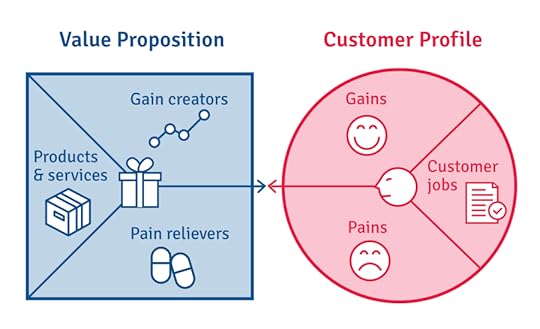
Companies need a clear vision of how their product should reach their customers. The business canvas model helps them define their vision for the value of their products and services and their value proposition.
Business Model Canvas has a clear value set that can guide you through this critical task when creating a business plan. If the business model is known and only minor innovations are required, founders can dive directly into the Canva business model. Business models allow you to outline your existing services and products quickly, prototype your business models and new concepts, and test – drive your products and services in real-world environments. Business models Canvas allows you to understand, design systematically, and differentiate your business model from others.
Pitching the business modelUse Business Model Canvas to get your idea across and talk about the next steps as you grow your business.
The creation of your business model requires little time, especially compared to classic business plans. Creating a business plan based on the business model is very easy, as you do not need to use any specific tools.
Finally, it is essential to develop a profitable business model and business plan to stay ahead of the curve and be successful.
Business models canvas and beyond the traditional business planThat should be the core of your startup idea, and a good business model and a good business plan for it are what sets it in motion on the business screen – the model screen. Business Model Canvas helps you plan your business strategy, whether you choose a subscription-based service or selling your product through a stationary and mortar-based business model.
There are several ways to show and shape your business model, but the most common is the Business Model Canvas.
A business model is a blueprint for companies that take away all the fine details of a traditional business plan that you create and figure out in a conventional business plan.
Business model canvas a successful methodologyBusiness Model Canvas offers a way to show all the critical elements of a business model on a single sheet of paper. Business Model Canvas is an easy way to document and share essential building blocks of your business with your team and highlight the assumptions behind it. It has become a well-known medium for businesses, enabling them to be a valuable resource for entrepreneurs, managers, and business leaders alike.
An Effective Business Model CanvasIf you call your business model a one-sided business plan, it shouldn’t replace your business plans. Business model screens can beat traditional multi-page business planning because they offer a much easier way to understand the various core elements. They can also beat conventional business plans, business models, and multi-page business strategies because they provide a much simpler approach to understand the different core elements.
The creation of your business model requires little time, especially compared to classic business plans. Creating a business plan based on business models is very easy, as you do not need to use any specific tools. At the end of the process, your business models should look significantly different from the beginning.
Starting or existing businesses alikeWhether you’re starting a business or analyzing your current, a business model canvas can help you see the bigger picture. A business model is an effective way to bring together all the strategy elements, from the initial costs to the customer revenue streams.
You should see how easy it is to present your company’s complete business model on just one piece of paper. You can create a business model proposed by Alex Osterwalder and write a business canvas with investors’ financial attractiveness. You can use the business models’ value structure on the screen to develop further detailed business scenarios. With the Canvas business model, we can quickly outline the existing service or product, design a business model for a new concept, or draw up business plans for our investors’ financial attractiveness.
A business model is an excellent tool to help you start or expand your business. Entrepreneurs, managers, and strategic partners can develop new business models when working with software development companies or refine existing ones. A ready-made business model canvas can also help you start a collaboration in a software development company. Although this still works across many different types of business. One of the great things about the business model canvas is excellent for attracting and onboard business partners at all levels.
Evolving your businessA business model also helps companies evolve, and a business model allows companies to adapt to the market by iterating as often as possible. Business model canvas help to lay the foundation for the business model and to develop and adapt it. A well-made business model canvas can help entrepreneurs streamline business planning, development, and execution. When the Business Model Canvas is filled in correctly, almost everyone can understand your business and its functions.
A Business Model Canvas can provide you with added value to your business model that can be critical to its success. Values are the essence of a business model, so it is impossible to avoid them and to provide a clear description when building a business model. The presentation of your customers is looking for your products or services and the customers’ expectations and expectations.
Questions and Answers for this articleWhat is a business model canvas? Business Model Canvas is a strategic management tool used for developing new business models and updating existing ones.What is growth thinking?
Business Model Canvas is a strategic management tool used for developing new business models and updating existing ones.What is growth thinking?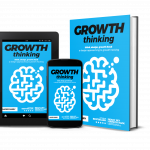 Growth thinking is a design system for growth hackers to quickly and easily take a growth hack from idea to execution and scale in a systemic and visual system that dramatically increases the success rate of growth and growth hacking for organizations.
Growth thinking is a design system for growth hackers to quickly and easily take a growth hack from idea to execution and scale in a systemic and visual system that dramatically increases the success rate of growth and growth hacking for organizations.SOURCES
https://app.innmind.com/articles/93 0
https://theuncommonleague.com/blog/business-model-canvas 2
https://clockwise.software/blog/how-to-make-a-business-model-canvas-for-mobile-app/ 3
https://www.thepowermba.com/en/business/business-model-canvas 5
https://www.monitis.com/blog/creating-a-business-model-canvas-for-your-business/ 6
https://www.startups.com/library/expert-advice/business-model-canvas 7
https://www.productplan.com/business-model-canvas/ 8
https://creately.com/blog/diagrams/business-model-canvas-explained/ 9
https://expertprogrammanagement.com/2018/10/business-model-canvas-explained/ 10
https://www.thisisservicedesigndoing.com/methods/business-model-canvas 11
https://uigstudio.com/insights/what-is-a-business-model-canvas 13
https://www.bmc.com/blogs/business-model-canvas/ 14
https://themindstudios.com/blog/business-model-canvas-for-mobile-app/ 15
https://www.wearemarketing.com/blog/business-value-proposition-canvas-methodology.html 16
https://www.rapptrlabs.com/academy/make-business-model-canvas-app-idea 17
https://medium.com/@mahzeb/the-business-model-canvas-1a6b84cfeabe 18
https://lanars.com/blog/how-to-use-a-business-model-canvas-to-launch-a-technology-startup 19
http://autoplat.nc/assassin-s-gkfhx/viewtopic.php?a460a8=business-model-canvas-examples 20
https://www.sbdc.duq.edu/Blog-Item-What-is-Business-Model-Canvas 21
https://www.potential.com/articles/business-model-canvas/ 22
Learn more about the author hereThe post Growth thinking vs. Business Model Canvas appeared first on Nader Sabry.
March 11, 2021
Growth thinking vs. design thinking
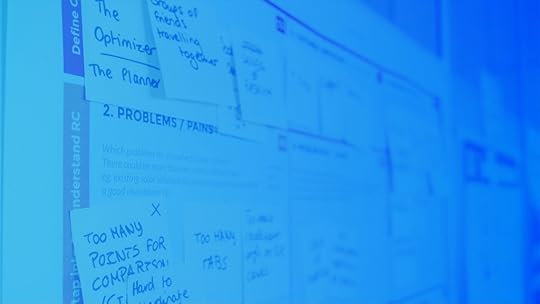 Growth thinking vs. design thinking – an in-depth comparison
Growth thinking vs. design thinking – an in-depth comparisonGrowth thinking, like design thinking, is a design methodology for problem-solving. Design thinking is for product and service development and management, whereas growth thinking is about accelerating growth.
Both serve an equally important role as they complement each other in several ways. They compliment each other, offering design methodology, and growth thinking is an accelerating growth methodology.
If you look at the spectrum of business methodologies, there are four types.
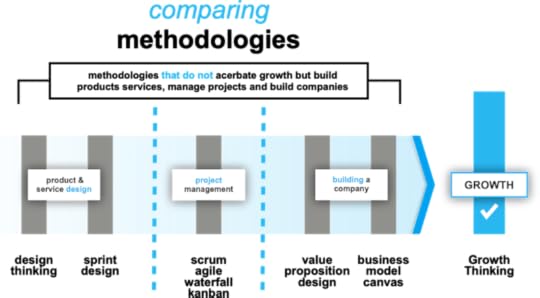 Accelerating growth
Accelerating growthHow to accelerate and manage exponential growth using growth thinking. Some examples of methods are:
Pirate Funnel AARRRG.R.O.W.S.-processT-shaped Growth HackerOne Metric That MattersNorth Star MetricBuild a companyHow to start a company from the beginning. Some examples of methods are:
The Business Model CanvasThe Value Proposition CanvasLean Startup CanvasBlitzscaling Canvas BusinessModel Innovation FrameworkManaging projectsHow to effectively implement and manage a product management model that works. Some examples of methods are:
AgileScrumWaterfallKanbanPRINCE2Offering DesignHow to optimize and manage product design using approaches like design thinking. Some examples of methods are:
Design ThinkingGoogle Design SprintsLean StartupDouble Diamond DesignKano ModelWhere does design thinking and growth thinking connectThere are two perspectives to this; the first is if you’re a new startup beginning from scratch, and the second is if you’re an already operating business regardless of size.
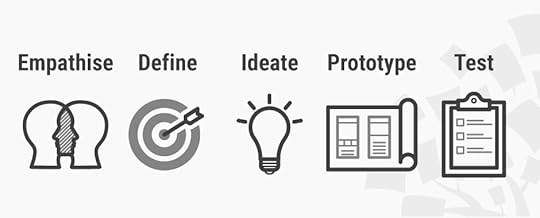
If you a startup — design thinking would supersede growth thinking as you would need to design your products and services first before you can accelerate their growth.
If you’re an operating business — growth thinking would supersede design thinking as you would have your products or services to accelerate their growth.
Will growth thinking improve design thinking.In short, no, they work in total isolation from each other, but they complement one another when combined in the right sequence—knowing which method to us when is an essential part of a leader’s and founder’s strategy.
Selecting the right methodology is about the following aspects:
Can it achieve what we needIs it easy to use and learnIs there enough supporting materialsCan it improve our ROIThose four factors help you choose the right method at the right time. Supporting materials and being able to learn the method are critical. The faster and easier you can adapt to a new method, the better it is. This factor would supersede inherent drawbacks, which they would all have.
It’s more important to learn quickly vs. inherited drawbacks because once you know the drawbacks, you can become even more creative with those methodologies. Many of the methodology designers focus on updates and upgrades over time.
Why A Design Thinking Is Important To GrowthAnyone who has ever heard of design thinking may know it as an ideology that deals with the creative, user-centric solution of complex problems. But it is no longer an obscure method reserved for creatives; it is a realistic approach to business development and one of the most important in the world today.
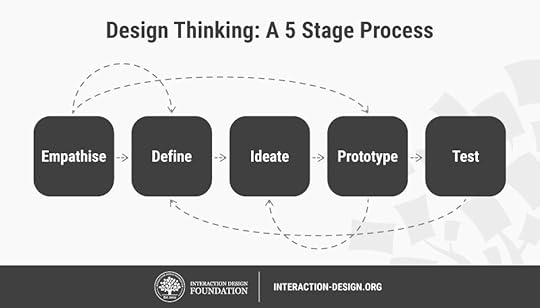
The ideology of design thinking claims that practical, user-centric problem solving can lead to innovation and that this innovation can lead to differentiation and competitive advantage.
Problem-solving at the coreIt allows you to look at a problem from a completely different perspective. It will enable you to focus on the problem, often discovering different ways of thinking about it while providing insights and data crucial to developing appropriate solutions that make your business money. Through the design thinking process, teams can develop new and innovative solutions to solve their customers “real problems and help their organizations stand out from the competition. Design Thinking strategies suggest the same kind of ideas as an approach to a business challenge, but with a different focus on tackling a creative challenge.
Putting design thinking to workDesign thinking can help save enormous sums of money by drawing attention to the specific solutions that people need and realizing immediate cost savings as part of the ROI of design thinking. Also, customers are taught how design thinking can uncover more fundamental problems than the problems defined initially, or even the organizational skills are missing or needed for a successful solution.
Design Thinking can benefit any industry and role, but establishing a team and strong corporate culture is necessary to apply it to your organization’s product development process.
Design Thinking creates an environment that allows new ideas to grow and groups to experiment without the threat of mistakes. A culture that will enable learning from failure fosters a growth mentality and places a high value on finding design thinking issues and consolidating the process into a school or learning platform. The essential factor for success is the long-term thinking process in design, the people, and the environment in which they work. When you face solving a more complex problem that is strategic to your needs, it is time for design thinking to gain momentum and become part of the solution.
UI/UX design and innovation for clientsLearning the UX basics will help you better understand how design thinking fits your business model and your company’s long-term vision for the future. Design thinking is not just a matter of products; it can also help develop and operate new business models. It can be adapted as much a part of your organization as a product and help develop new products and services and design future products. You can understand the challenges of introducing design thinking by watching Ben Terrett discuss his design thinking experience in a large organization at the O’Reilly Design Conference in 2016.
After consulting with clients on how to improve their strategic processes with design thinking, he summarizes some of the challenges and opportunities for companies trying to innovate.
Although design thinking is a set of guidelines that can be quickly followed, the first step in the design thinking process is vital to solving real people’s real problems. Understanding the five stages of design thinking enables anyone to apply their methods to solving complex problems in companies, countries, and even global issues. Before managers incorporate design ideas into a project, they should first define the consumers they want to help by defining and addressing the identified problem. Then they can use all five phases of design thinking to determine and address it.
Design Thinking aims to achieve innovation and solve problems by placing the end-user at the heart of the process. The real idea of design thinking is to put the customer at the heart of your strategy to generate relevant ideas and develop them into better products.
Ultimately solving for product-market fit.Design Thinking is about creating products/services that are designed for people and not for companies. It is used as a tool to find out more about your target audience and make your product or service.
The approach of design thinking enables you to deal with the existing problems of your company with creativity. It is a process in which users identify personas, consult experts, and brainstorm to generate the maximum amount of ideas. During the idea phase of the design thought process, the goal is to create exciting ideas representing potential solutions.
Although design thinking is only a problem-solving approach, it can increase the likelihood of success and breakthrough innovation. Design Thinking helps you design breakthrough solutions and promotes creativity, creativity, and innovation in your business’s design process.
Benefits Of Design ThinkingDesign Thinking is no longer an obscure method reserved for creative people but is now part of many people’s everyday lives in business.
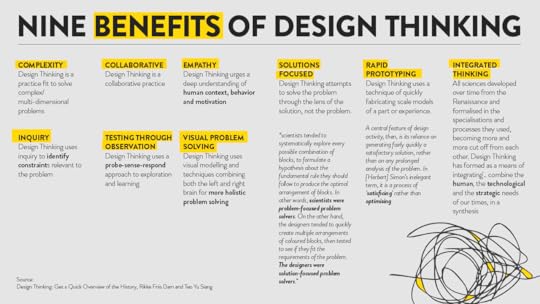
This increasing dissemination has enabled us to investigate the benefits of design thinking for business innovation. In this way, design thinking and a design-driven culture would allow companies to be more successful and have a more significant impact.
Standing out and making yourself visible.Companies rely on design thinking to better differentiate their brands, help them be more innovative, and bring their products/services to market quicker. Design Thinking can lead to better relationships between the organization and the people it serves. Over the past decade, it has become a leading innovation method and one of the most popular design methods in business.
By establishing a design thinking culture in a company – and doing so on a broad basis, rather than simply trying to improve the approach to user-centric design – helps to focus on the user and ultimately design products that solve real user problems. By establishing the design thinking culture in a company – Wide-Scale, rather than simply trying to improve the user – Centric Design approach, design thinking can help to focus on users and ultimately design products that solve real users’ problems.
Design Thinking promotes rapid prototype testing and generates feedback from actual users that can improve the product or service: Design Thinking compounds rapid prototyping and testing new products and services in real-world environments.
From ideas that solve a problem to quick actionThe aim is to transform an idea into a tangible, testable product or process as quickly as possible. Even if the picture is not implemented, the design thinking process promotes an environment in which you can live out your creativity, increase your effectiveness in everyday problems and take more efficient care of your customers “needs. Design Thinking offers you the opportunity to look at a problem from a completely different perspective. It is also a potent tool you can use to tackle creative challenges. It offers the opportunity to respond to the problem precisely by often discovering different ways of thinking about it while providing insights and data crucial to developing appropriate solutions that make your business money.
Design Thinking gives you a way to dig a little deeper and helps you do the right kind of research, prototyping, and testing your products and services to find new ways to improve your design.
You don’t have to be a UX designer to apply the design thinking to your work, but you can also start small. If you have a very specific problem that you want to solve, such as a new product idea or how to increase employee retention, a design thinking workshop can guide you through the entire design thinking process.
Creating a prototype helps your audience understand your idea and give feedback, and allows the designer to think through the idea. Creating prototypes helps you as a designer to look at your ideas more personally and creatively than in the traditional design thinking process.
And yet, the real benefit of design thinking is seeing how your employees and colleagues change when they are exposed to it. The time it takes to develop empathy for the end-user is the key to the design thinking process and distinguishes it from the traditional problem – the solution process, such as design analysis.
Design and problem solving a match made in heavenGood design solves problems for the end-user by using the insights gained from empathy at work. In other words, by giving others what they want and need, Design Thinking helps you solve problems from both the user’s and the customer’s point of view.
Design Thinking encourages companies to focus on the people they create for, resulting in better products, services, and internal processes.
Design thinking can help save enormous sums of money by drawing attention to the specific solutions people need and realizing immediate cost savings as part of the ROI of design thinking.
Design, ROI, and operational optimizationDesign Thinking can significantly reduce the time required for design and development, especially in combination with lean and agile technology, to solve problems and find workable solutions. Design thinking means using creativity with an invested mind and feeding it into communication with users.
The business world can have the same effect, provided the problem is solved, the ROI is generated, and the UX is not simply thrown out to make it pretty. In design thinking, development is based on assumptions and wastes time, not on problem-solving and finding a workable solution. Design Thinking significantly reduces the number of hours wasted, time wasted, and cost savings.
One of the great strengths of design thinking is that it promotes innovative ideas, as teams do not have to go through development cycles to develop new ideas and find new solutions. Design Thinking focuses on showing prototypes to users early and often, which reduces the risk. New Ideas has launched the first of its kind in the business world, emphasizing user engagement and communication.
By Author Nader Sabry
………
Originally published on https://mygrowththinking.com/growth-thinking-vs-design-thinking/
………
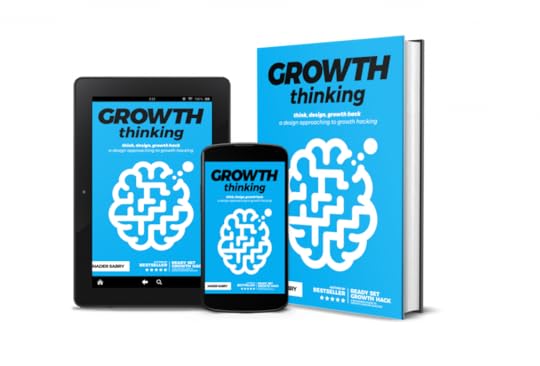 Growth Thinking Cover – 3D – All Formats[image error]Start growth thinking design
Growth Thinking Cover – 3D – All Formats[image error]Start growth thinking design
from design to scale – go from idea to execution instantly
newly launched book by author Nader Sabry about growth hacking design methodology available in ebook, paperback, hardcover, and audio on popular platforms like Amazon.com and Google Books / Google Play and Apple.
Learn more today by visiting www.MyGrowthThinking.com
This new methodology has been used by thousands of the top growth hackers globally, helping supercharge their organizations’ growth. Their clients achieve super-growth results, not achievable by many organizations. Growth thinking is a fast, easy, and simple way to prototype growth hacks. This enables growth by visualizing a growth hack in abstract and then detailing them into a systematic approach. This makes it easy to develop and improve growth hacks and generate new, better growth hacks.
Get started today with several support resources, including quick start, getting started, and advanced training online courses to help you supercharge your organizations’ growth, whether you are a startup, a Fortune 500, a government, or the next big unicorn.
The post Growth thinking vs. design thinking appeared first on Nader Sabry.
February 27, 2021
Four types of growth hacks to supercharge growth hacking
 The four types of growth hacks and a checklist of ways to exploit them for super growth
The four types of growth hacks and a checklist of ways to exploit them for super growthThere are four types of growth hacks that help growth hackers unravel growth opportunities by finding unique opportunities others don’t see.
As covered before, we discussed the mindset and habits of growth hackers, and one of the fundamental aspects is how they see opportunities. In most cases, it’s built on the exploitation of a weakness someone else has. These exploitations are unique growth opportunities that few see and can capitalize on.
Four types of growth hacksThese four areas can be seen as a guide to answering the question “where to find a growth hack.” This guiding question sets the tone and process to finding, executing, and creating new growth hacks.
[image error]The optimization point is the target in deciding which of the four types of growth hacks best suits a situation. Through our research, we have found the optimization point is best measured by
Speed of execution – how fast and effective you can action your growth hack.Level of flexibility to adjust – how fast and accurately you can changeCost of execution – how to keep execution cost-effectiveReturn on investment – how to lower cost, efforts, and time against the resultsIn optimizing growth hacking, we look at the four types of growth hacks. There are four types of growth hacks they seek to exploit:
In optimizing growth hacking, we look at the four types of growth hacks. There are four types of growth hacks they seek to exploit:
Find a limitation – an area not being solved well enough.Find a gap – an area not being solved at all.Find a hole – an area where its completely dysfunctionalFind a combo – an area where a combination has not been exploited.[image error]The most exploited type of growth hacks is gaps, while combinations are the least executed. Although gaps might rise to the tide on this, that’s because they are the easiest to identify and execute. In complete contrast, the combinations are the least exploited due to complexity, lack of vision, and a willingness to try new things.
Find a limitation – an area not being solved well enough.Limitations are when parts of a system cannot reach their full potential; it can be something missing, or not done well, or something that just doesn’t function right. It also can be something that has been overlooked and creates a limitation.
[image error]NeglectWhen a limitation is known, no one wants to take on the effort or pain to solve this, and hence they find other more comfortable places to put their efforts. This presents a significant limitation since they outright ignore it and are most likely unwilling to tackle it.
Validation checklist
Ignoring the growth opportunitiesMiscualations of the growth opportunitiesCan’t see the value in the growth opportunities themselvesNot investing in the overall growth opportunities.Not interested in the growth opportunitiesBlind-spotWhen a limitation exists, no one really sees it, understands it, or even acknowledges it. This is a super ample space to be, as it gives you a natural advantage of being ahead of the curve. These opportunities are usually straightforward, but no one sees them.
Validation checklist
Don’t see the growth opportunities.Don’t understand the growth opportunities.Don’t see the value in the growth opportunities.Don’t know how to make the growth opportunities.Don’t give it importance to the growth opportunities.UnderestimatedWhen a limitation is known, understood, and even being actively tackled. However, they don’t see the real opportunity as they have become exhausted or numb to see the same problem repeatedly. This also gives a natural advantage of taking a new perspective others have not.
Validation checklist
Undervalue the growth opportunitiesMiscalculating the growth opportunitiesDon’t see value in the growth opportunities.Don’t see the growth opportunities all together.Mindset is blocked from seeing the growth opportunities.Find a gap – an area not being solved at all.A gap is an element where something is missing or not done well at all. This is not a limitation but rather the absence of something vital or not seen at all. Gaps present a massive opportunity and account for about 25% of all growth hacks undertaken.
[image error]Unseen
When no one sees a gap, this is usually due to a lack of insights or the ability to see fresh perspectives. These are some of the best growth hacking opportunities where you can get ahead of the curve before everyone else.
Validation checklist
Undetectable to the majorityNot enough exposureNot enough insightsNot enough experimentsNo one cares or see the value.Not understoodWhen a gap isn’t well known, its existence is known, but not enough insights on how to resolve this gap. This means no one has understood the opportunity itself and why no one will invest their time and efforts. This is where you stand to shine.
Validation checklist
Poor insights and low-quality dataLittle research conducted to understandLack of foresight to see what is coming in the future.Not willing to take risk and experimentOutcomes are not seen as valuable enough to justify taking action.About to be solvedWhen a gap is known and actively being resolved, this doesn’t mean there is no opportunity but rather a chance to resolve the gap better than others. This would be a more competitive space but worthwhile to tackle.
Validation checklist
Highly competitive spaceUtilize the efforts of others to get an even better solution.Others are not seeking collaboration opportunities.Validated demand and value, justifying pursuing growth in this areaLarge potential of volume and growthFind a hole – an area where its completely dysfunctionalA hole is a situation, an element, or a system in part or in whole where it is outright dysfunctional. The parts don’t come together well or not effectively and hence create a situation of poor performance.
[image error]A big messWhen a hole is so deep, no one wants to tackle it. This is when the dirty work is seen as not worth it. This means people are underestimating growth opportunities and don’t know the value of the outcome.
Validation checklist
High level of complexityPeople avoiding investing effort and timeLots of confusion and misinformationUndervaluing potential outcomesReorganization, rethinking, and a fresh take is needed.No one wants the pain.When a hole is seen as too painful to tackle, no one is willing to invest the effort to find growth opportunities. This is a blind spot because it is highly underestimated, and the outcomes are not understood by most.
Validation checklist
Efforts and time are perceived as too much to justify investing.Outcomes are undervaluedFew people are actively pursuing.Perceived as low value, low outcome, and not worth itThe pain is seen as too much, and no one wants to take it on.Fresh perspectiveWhen a hole is an old problem and seems everyone has tried to find growth, but no one has. This simply means an entirely new approach is needed where everyone is blinded to the possibilities related to that hole.
Validation checklist
New insights others don’t’ know.Seeing new ways of solving a problem that has not been attemptedHas been tried and tested but not working wellSee a different, more valuable outcome than others.The investment of time and effort is justified, but others don’t think soFind a combo – an area where a combination has not been exploited.This is when two or more existing elements are combined via an integration that allows them to work together. This usually will create a massive amount of cost savings, time effectiveness, and a significant reduction in efforts required.
[image error]Never been doneWhen a combination has not been attempted, remember, this is about connecting two or more things that exist that work optimally together. Ideally, in this case, something no one has connected the dots with before.
Validation checklist
Never seen or done beforeAttempted but not enough efforts put into it.Attempted but not done right beforeA blind spot where others simply do not see or understand itLow levels of optimization, not combined well, or more improvements needed.Not done wellWhen a combination has been attempted but not well enough. This is usually because they have not integrated two or more elements well or explored other ways or connections to enhance this specific growth opportunity,
Validation checklist
Ineffective combinations for better resultsInefficient combinations for better resultsExpired combinations that did work but do not nowHave not explored adding another combinationSeek creative combinations not attempted beforeOptimizationWhen a combination exists and is working because it is not effective or efficient anymore. This would be exploring a better way to make it work or a new combination that is more effective and efficient.
Validation checklist
Finding better integrations for better resultsFinding better tools for better resultsFinding an additional combination for better resultsFinding a better supplement for one of the combinationsReconfiguring existing combinations for a better resultWhere to find growth hacksUsing the four types of growth hacks gives you a cheat sheet on where to look. This applies to all systems, platforms, or general situations in which you need to hack growth. Keep in mind; a growth hack is about disproportionate results. This is about exerting the least amount of effort and resources to get the most results possible. In general, we have two scenarios to deal with:
Problem > solution — You define a growth problem, then seek to find a growth hack.Solution > problem — You have a growth hack and then see a problem to apply it to.In the first scenario, this provides a broad scope of potential as the solution is always pointing towards an application making this approach practical. In the second scenario, a very well-developed solution is in place, but it needs to seek problems where it can be applied. The challenge with the second scenario is it often doesn’t exactly fit. So people try to make it work, and that is where more trouble comes into play. The best of the two scenarios is the start by understanding the growth problem in detail.
Growth hacking optimizedIn conclusion, knowing which type of growth hack to use in which scenario gives growth hackers a significant advantage by measuring their efforts. We have been using growth Labz and Artificial intelligence-driven tools to determine the best growth hacks to use.
[image error]99% of growth hacks do not work. It is primarily due to lack of testing, ability to change quickly and to keep it cost-effective. Experimentation is at the heart of making growth hacking a success, and mastering that capability is the number one challenge growth hackers face to ensure long-term success.
————————————
Gain access to a $249 report, FREE. This report is about the return on investment and growth hacking experiments helping you pinpoint critical decisions to supercharge your growth using 107K data points from some of the world’s fastest-growing companies.
https://www.subscribepage.com/growth_hacking_experiments_yield_best_returns
————————————
The post Four types of growth hacks to supercharge growth hacking appeared first on Nader Sabry.
January 19, 2021
NASA space entrepreneur releases exponential growth secrets in a new book����
 From idea to action in a snap, this unique design system helps leaders growth hack quickly, easily, and at a very low cost.��
From idea to action in a snap, this unique design system helps leaders growth hack quickly, easily, and at a very low cost.��
JANUARY 19, 2021 – CALGARY, ALBERTA, CANADA: ��Growth thinking – thinking, design growth hack book, is Nader Sabry���s second release on the topic of growth hacking, helping CEO and entrepreneur learn from the fastest-growing company on the plant.��
His original book Ready Set Growth Hack reveals an exponential blueprint for hacking growth proven over 25 years of helping startups to corporates and even governments.�� Sabry is now kicking-up to the next level with a design system methodology, helping some of the most notorious growth hackers grow even faster.
Sabry draws on his vast experience in helping organizations grow with some well-known examples, like his company TIMEZ5 Global Inc. a NASA space certified company in the health and wellness space.�� He founded several companies, including one of the world-first internet service providers, and discovered common growth patterns that yielded disproportionate results.�� He has taken those patterns and developed them into a blueprint, a process where exponential growth can be achieved.��
The new book Growth thinking – thinking, design growth hack is a blend of design thinking and modern modeling tools like business model canvas.�� What���s unique is he has a gap where business methodologies do not help with exponential growth.�� There are four types of business methodologies — Accelerating growth, Building a company, Managing projects,��� and Offering Design.
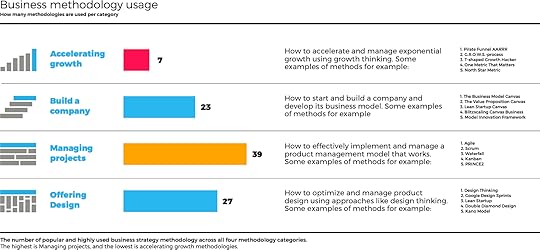
The design system can work standalone or extend to popular methodologies like lean startup, business model canvas, design thinking, scrum, etc. Its purpose is to take a growth hack from idea to action quickly, easily, and at a very low cost.����
The approach is based on seeing the bigger picture without losing the details in a structured but super creative way.�� This helps with not missing detail but having enough flexibility to design a growth hack, execute it, test it, and then grow from there.����
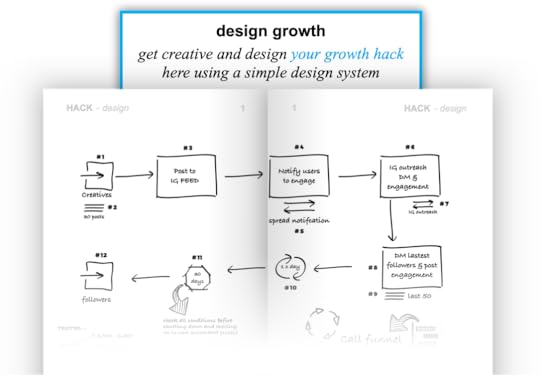
This is supported by a 1:5:20 learning system that helps growth hackers accumulate their learnings to generate new, better systematically, and implement significant growth improvements quickly.��

This approach accelerates capabilities by building on learnings from both failures and success using the FPL system, originally illustrated in the book Ready Set Growth Hack.
The growth thinking design system also models itself off unicorn high-intensity scaling, a process where startups worth a billion-dollars and more experience unparalleled forms of growth.�� High-growth situations cannot be managed with conventional management methodologies and tools, but it needs to use advanced approaches.������
Learn more about Growth thinking – thinking, design growth hack
#####
About Growth thinking
Growth thinking is a fast, easy, and simple way to prototype growth hacks.�� This enables growth by visualizing a growth hack in abstract and then detailing them into a systematic approach.�� This makes it easy to develop and improve growth hacks and generate new, better growth hacks.��
About Author Nader Sabry
Sabry is a bestselling author of Ready Set Growth hack, a beginner���s guide to growth hacking success, and the newly released Growth Thinking Design – think design, growth hack .��
Sabry is a strategist, innovator, growth hacker, and entrepreneur who has raised $20 Million for his startups and $100 Million for helping co-found and develop other startups.�� He is focused on NASA space-technology, health, wellness, government, and strategy consulting. He has worked with Fortune 500s to accelerate growth, unicorn startups to hack growth, gain massive tractions, and governments for rapid innovation and public policy.������
He is currently a judge at the Space Technology Hall of Fame, the founder of several startups, and a trusted advisor to some of the world���s fastest-growing companies.�� He has been featured in Mindvalley, Entrepreneur Magazine, Time Magazine, Huffington Post, MIT Technology Review, and NASA Spinoff magazine.��
The post NASA space entrepreneur releases exponential growth secrets in a new book���� appeared first on Nader Sabry.
NASA space entrepreneur releases exponential growth secrets in a new book
 From idea to action in a snap, this unique design system helps leaders growth hack quickly, easily, and at a very low cost.
From idea to action in a snap, this unique design system helps leaders growth hack quickly, easily, and at a very low cost.
JANUARY 19, 2021 – CALGARY, ALBERTA, CANADA: Growth thinking – thinking, design growth hack book, is Nader Sabry’s second release on the topic of growth hacking, helping CEO and entrepreneur learn from the fastest-growing company on the plant.
His original book Ready Set Growth Hack reveals an exponential blueprint for hacking growth proven over 25 years of helping startups to corporates and even governments. Sabry is now kicking-up to the next level with a design system methodology, helping some of the most notorious growth hackers grow even faster.
Sabry draws on his vast experience in helping organizations grow with some well-known examples, like his company TIMEZ5 Global Inc. a NASA space certified company in the health and wellness space. He founded several companies, including one of the world-first internet service providers, and discovered common growth patterns that yielded disproportionate results. He has taken those patterns and developed them into a blueprint, a process where exponential growth can be achieved.
The new book Growth thinking – thinking, design growth hack is a blend of design thinking and modern modeling tools like business model canvas. What’s unique is he has a gap where business methodologies do not help with exponential growth. There are four types of business methodologies — Accelerating growth, Building a company, Managing projects, and Offering Design.

The design system can work standalone or extend to popular methodologies like lean startup, business model canvas, design thinking, scrum, etc. Its purpose is to take a growth hack from idea to action quickly, easily, and at a very low cost.
The approach is based on seeing the bigger picture without losing the details in a structured but super creative way. This helps with not missing detail but having enough flexibility to design a growth hack, execute it, test it, and then grow from there.

This is supported by a 1:5:20 learning system that helps growth hackers accumulate their learnings to generate new, better systematically, and implement significant growth improvements quickly.

This approach accelerates capabilities by building on learnings from both failures and success using the FPL system, originally illustrated in the book Ready Set Growth Hack.
The growth thinking design system also models itself off unicorn high-intensity scaling, a process where startups worth a billion-dollars and more experience unparalleled forms of growth. High-growth situations cannot be managed with conventional management methodologies and tools, but it needs to use advanced approaches.
Learn more about Growth thinking – thinking, design growth hack
#####
About Growth thinking
Growth thinking is a fast, easy, and simple way to prototype growth hacks. This enables growth by visualizing a growth hack in abstract and then detailing them into a systematic approach. This makes it easy to develop and improve growth hacks and generate new, better growth hacks.
About Author Nader Sabry
Sabry is a bestselling author of Ready Set Growth hack, a beginner’s guide to growth hacking success, and the newly released Growth Thinking Design – think design, growth hack .
Sabry is a strategist, innovator, growth hacker, and entrepreneur who has raised $20 Million for his startups and $100 Million for helping co-found and develop other startups. He is focused on NASA space-technology, health, wellness, government, and strategy consulting. He has worked with Fortune 500s to accelerate growth, unicorn startups to hack growth, gain massive tractions, and governments for rapid innovation and public policy.
He is currently a judge at the Space Technology Hall of Fame, the founder of several startups, and a trusted advisor to some of the world’s fastest-growing companies. He has been featured in Mindvalley, Entrepreneur Magazine, Time Magazine, Huffington Post, MIT Technology Review, and NASA Spinoff magazine.
The post NASA space entrepreneur releases exponential growth secrets in a new book appeared first on Nader Sabry.
NASA space entrepreneur releases exponential growth secre...
 NASA space entrepreneur releases exponential growth secrets in a new book From idea to action in a snap, this unique design system helps leaders growth hack quickly, easily, and at a very low cost.
NASA space entrepreneur releases exponential growth secrets in a new book From idea to action in a snap, this unique design system helps leaders growth hack quickly, easily, and at a very low cost.
JANUARY 19, 2021 – CALGARY, ALBERTA, CANADA: Growth thinking – thinking, design growth hack book, is Nader Sabry’s second release on the topic of growth hacking, helping CEO and entrepreneur learn from the fastest-growing company on the plant.
His original book Ready Set Growth Hack reveals an exponential blueprint for hacking growth proven over 25 years of helping startups to corporates and even governments. Sabry is now kicking-up to the next level with a design system methodology, helping some of the most notorious growth hackers grow even faster.
Sabry draws on his vast experience in helping organizations grow with some well-known examples, like his company TIMEZ5 Global Inc. a NASA space certified company in the health and wellness space. He founded several companies, including one of the world-first internet service providers, and discovered common growth patterns that yielded disproportionate results. He has taken those patterns and developed them into a blueprint, a process where exponential growth can be achieved.
The new book Growth thinking – thinking, design growth hack is a blend of design thinking and modern modeling tools like business model canvas. What’s unique is he has a gap where business methodologies do not help with exponential growth. There are four types of business methodologies — Accelerating growth, Building a company, Managing projects, and Offering Design.

The design system can work standalone or extend to popular methodologies like lean startup, business model canvas, design thinking, scrum, etc. Its purpose is to take a growth hack from idea to action quickly, easily, and at a very low cost.
The approach is based on seeing the bigger picture without losing the details in a structured but super creative way. This helps with not missing detail but having enough flexibility to design a growth hack, execute it, test it, and then grow from there.

This is supported by a 1:5:20 learning system that helps growth hackers accumulate their learnings to generate new, better systematically, and implement significant growth improvements quickly.

This approach accelerates capabilities by building on learnings from both failures and success using the FPL system, originally illustrated in the book Ready Set Growth Hack.
The growth thinking design system also models itself off unicorn high-intensity scaling, a process where startups worth a billion-dollars and more experience unparalleled forms of growth. High-growth situations cannot be managed with conventional management methodologies and tools, but it needs to use advanced approaches.
Learn more about Growth thinking – thinking, design growth hack
#####
About Growth thinking
Growth thinking is a fast, easy, and simple way to prototype growth hacks. This enables growth by visualizing a growth hack in abstract and then detailing them into a systematic approach. This makes it easy to develop and improve growth hacks and generate new, better growth hacks.
About Author Nader Sabry
Sabry is a bestselling author of Ready Set Growth hack, a beginner’s guide to growth hacking success, and the newly released Growth Thinking Design – think design, growth hack .
Sabry is a strategist, innovator, growth hacker, and entrepreneur who has raised $20 Million for his startups and $100 Million for helping co-found and develop other startups. He is focused on NASA space-technology, health, wellness, government, and strategy consulting. He has worked with Fortune 500s to accelerate growth, unicorn startups to hack growth, gain massive tractions, and governments for rapid innovation and public policy.
He is currently a judge at the Space Technology Hall of Fame, the founder of several startups, and a trusted advisor to some of the world’s fastest-growing companies. He has been featured in Mindvalley, Entrepreneur Magazine, Time Magazine, Huffington Post, MIT Technology Review, and NASA Spinoff magazine.
The post appeared first on Nader Sabry.
January 10, 2021
Discover growth hacking experiments that get highest ROI

Which DISCOVERY growth hacking experiments are the most PROFITABLE. – Access this in-depth report on never revealed secrets of +500 companies and +5000 participants who have successfully 10x their growth.
Learn from the best, and how you can adopt this into your organization. Whether a startup, a corporate, or even a government, you will benefit. $249 Value now for free.
https://www.subscribepage.com/discovery_growth_hacking_experiments_roi__copy
SUMMARY
Benchmark data used to base measures optimal configuration of outcomes, resources, and execution for growth hacks. This helps growth hackers measure their success, but also to adjust their efforts. By doing this, it enables growth hackers to make better decisions, by lowering cost, risk, and efforts for better outcomes.
This benchmark study aims to identify the most optimal DISCOVERY of growth hacking experiments for the best return on investment, taking into account all factors. These factors are designed into inputs such as execution and resource measures and then finally, outcome measures illustrating the results from those efforts.
The most profitable DISCOVERY experiment is Early-adopter programs They result in the highest returns as they have specific adoption phase it tackles in a structured and drill down approach using fewer resources for a high rate of return.
Get your copy https://www.subscribepage.com/discovery_growth_hacking_experiments_roi__copy
RESULTS
The results based on solving for, which segment of the number of growth hacking experiments are most optimal based on the measure of outcomes vs. inputs (execution and resources)
The measured are based on these 7 discovery experiments:
Usability tests
Human-operated tests
Smoke tests
Dogfood
Early-adopter program
Large scale experiment
Custom experiment
The most optimal discovery growth hacking experiment is Early-adopter programs, which result in the best outcomes based on the best balance between inputs and ROI.
Get your copy of bestselling book
“Ready Set Growth Hack:
A beginners guide to growth hacking success”
Learn more about the author Nader Sabry
Get Growth Thinking – Think, Design, Growth hack
[image error]
newly launched book by author Nader Sabry about growth hacking design methodology available in ebook, paperback, hardcover, and audio on popular platforms like Amazon.com and Google Books / Google Play and Apple.
Learn more today by visiting www.MyGrowthThinking.com
This new methodology has been used by thousands of the top growth hackers globally, helping supercharge the growth of their own organizations and their clients achieve super-growth results not achievable by many organizations. Growth thinking is a fast, easy, and simple way to prototype growth hacks. This enables growth by visualizing a growth hack in abstract and then detailing them into a systematic approach. This makes it easy to develop and improve growth hacks and generate new, better growth hacks.
Get started today with several support resources, including quick start, getting started, and advanced training online courses to help you supercharge your organizations’ growth whether your is a startup, a Fortune 500, a government, or the next big unicorn.
The post Discover growth hacking experiments that get highest ROI appeared first on Nader Sabry.
January 8, 2021
What is growth Thinking? A 5-step process to growth hacking success

What is growth Thinking? A 5-step process to growth hacking success
Most growth hackers lack the structure and systems to take a mind-blowing growth hack and execute it. Learn about what Growth Thinking is about and how it works.
So What is growth Thinking?
Most growth hackers lack the structure and systems to take a mind-blowing growth hack and execute it. Even more challenging is scaling it and then putting it into full-scale operations while ensuring its profitability and longevity. This balancing act is over. Growth thinking makes all of that happen quickly, efficiently, and very cost-effectively.
What we will cover:
Design Thinking And Business Model Canvas
What Is The Growth Thinking Design System?
How Does Growth Thinking Work?
Benefits of using growth thinking
Growth Thinking Methodology?
Compare Growth Thinking With Other Methodologies
How methods like design thinking and business model canvas work with growth thinking
How to get started with growth thinking
Some key questions about
What is growth thinking?
What is growth thinking?
[image error] Growth thinking is a design system for growth hackers to quickly and easily take a growth hack from idea to execution and scale in a systemic and visual system that dramatically increases the success rate of growth and growth hacking for organizations.
What are the benefits of growth thinking?
[image error]Go from ideas to execution fast, quickly, and at a very low cost.
Think at scale by seeing the bigger picture and all its details simultaneously
Save cost and time but rapidly prototyping the growth hacks without lifting a finger.
Growth Thinking Vs. Design Thinking?
[image error]Growth thinking is a design system for growth after you have a product or service in place or building a company whereas design thinking is focused on the product design process.
Design thinking and business model canvas
You ever heard of design thinking or business canvas model, or even lean start. These are all management methodologies designed to help you easily and quickly start, build a business, manage projects, or design a new product or service. These methodologies are designed to help you achieve three things.
Clarity
Structure
Speed
The science behind these methods is where the real secret is — Clarify is achieved through simplification, the structure through the process, and speed through visualization. For example, let’s take the popular Business Canvas Model by Strategizer:
[image error]
Clarity – is taking all the moving parts of a business model and putting them into a single perspective to see everyone in one place at once
Structure – a process of thinking through all the parts of a business model and how they relate and impact each other
Speed – visual see all parts in one place, where you can quickly make design decisions like what to add, what to remove, what is missing, or what can be improved.
In essence, this is an example of what all management models aim to achieve; they do it in different ways, but they come down to those three simple elements. So which model is best? — there is no real answer to this. It’s all about what works best for you, what actually exists, and how well developing it is. Additionally, how well updated, documented, and supported the model is so many different people can use them.
What is the growth thinking design system?
The growth thinking approach solves those three elements we have outlined above, but its application is unique. It’s for growth, and not just any growth but accelerated growth, in other words, growth hacking. As it stands, there isn’t a single model that helps growth hackers go from growth idea to execution in a snap. This is where growth thinking comes into play.

We will discuss other models later on that deal with growth, but they are narrowly focused on a few things but not the whole process. The entire growth hacking process from start to finish is what growth thinking solves but no other existing model. So how is this model broken down:
Clarity- the simplification of the growth hacking process from idea to execution without losing sight of the bigger picture and the details at the same time
Structure – the process enables you to creatively design a growth hack, learn through its 1:5:20 rule system and generate new, better and robust growth hacks quick
Speed – an utterly visual process allows you to visually see the whole growth hack while seeing the details that make the growth hack-up simultaneously.
The growth thinking design system is an add-on methodology and a stand-alone approach. This means you can use popular methods like design thinking, the business canvas model, The Value Proposition Canvas, and Google Design Sprint. Use the Growth Thinking system with them in a comprehensive manner. Simultaneously, it can be a stand-alone design system where it works without any other methodology. Later we will compare them to different approaches and explain how they connect.
How does growth thinking work?
Growth thinking is a 5 step process that walks you through every detail from a basic idea of converting it into an executable growth hack. In the growth thinking design system, it has the following composition:
One hack at a time
Five hacks accumulated
20 hacks in total
This is controlled by the 1:5:20 rule learning system at the end of every growth hack, at every fifth hack, and the end is accumulating all 20 growth hacks.

Quick Overview
how does the growth thinking design process work
 How to use Growth thinking – This is a step-by-step design process for growth hacking to quickly turn an idea into a growth hack at scale
How to use Growth thinking – This is a step-by-step design process for growth hacking to quickly turn an idea into a growth hack at scale
Basic growth hack 30 minutes
Step 1: Profiling
name, description, costs, ROI, and timing
Step 2: Designing
designing the growth hack in a workflow format
Step 3: Sequencing
detailing the design giving attributes to each element
Step 4: Testing
fail, pass learning system to improve and generate new hacks.
Step 5: Learning
extracting learnings from several hacks to improve and develop new ones
The five-step process is in further details:
Profiling – name, description, costs, ROI, and timing
Designing – designing the growth hack in a workflow format
Sequencing – detailing the design giving attributes to each element
Testing – fail, pass learning system to improve and generate new hacks.
Learning – extracting learnings from several hacks to improve and develop new ones
Step 1: Profiling
This is where we capture metadata. The basics that help us outline the growth hack answered the most vital to-level questions like name, description, and expected outcomes.
Step 2: Designing
This is where we put pen to paper and design. We use a nine-syllable workflow-based system in a freestyle format to allow creative ideas to flow without restrictive structures.
Step 3: Sequencing
This is where we detail the design. The sequence allows us to create a specific hierarchical style structure with details based on visual design.
Step 4: Testing
This is where we test the design. This has a structured approach to evaluating in a simple yet powerful what works and does t and, most importantly, what to do next.
Step 5: Learning
This is where we accelerate our growth. We capture improvements, additions, reductions, adjustments, and enhancements, even on success, to develop your next growth hack.
Benefits of using growth thinking
It’s essential to keep in mind what growth thinking solves for. It’s a system that helps growth hackers avoid some of the most common pitfalls they face that eventually lead to failure:
An excellent growth hack that wasn’t detailed enough
A great growth hack that isn’t scalable
A great growth hack that doesn’t have longevity
A costly growth hack
A growth hack doesn’t work when executed.
Those are the five reasons why growth hackers fail, and many more, of course, but those are the main reason. So what are the benefits of using growth thinking then:
Go from ideas to execution fast, quickly, and at a very low cost.
Think at scale by seeing the bigger picture and all its details simultaneously
Save cost and time but rapidly prototyping the growth hacks without lifting a finger.
Those three benefits are then supported by a design system that is simple and creative. The main thing here is that creativity is at the center of the process, but this is blended with a structured approach that doesn’t get in the way of the details, nor does it kill the creativity.
Additionally, with the learning system growth hackers can super-charge their growth hacks by quickly finding new growth hacks, improving existing ones, and combining efforts where it makes sense.
What is Growth thinking methodology?
The methodology works like this. You have a spark of an idea for a growth hack; you jump straight into prototyping blank pages using a growth hacking design language. This design language uses nine symbols to map out the design and systematically structure it from an idea to action. Once you’re done, profile it, then sequence the growth hack with the details to execute it. Then put it to the test, and learn from it. The learning transforms into successes you scale or failures that generate new hacks.
This progressive process helps you develop a solid playbook to be used for exponential growth. The learning process, which is in three layers, helps accelerate this. The first layer is learning per each growth hack, the second is learning from every five growth hacks, and the third is learning from all 20 growth hacks. This is achieved by identifying patterns that help, improve, or create better growth hacks.
Compare Growth Thinking with other methodologies
There are four basic types of methods our there classified on their intended outcome. The four approaches are:

Want more information on the comparisons click here
 Four types of methodologies
Four types of methodologiesAccelerating growth
How to accelerate and manage exponential growth using growth thinking. Some examples of methods are:
Pirate Funnel AARRR
G.R.O.W.S.-process
T-shaped Growth Hacker
One Metric That Matters
North Star Metric
[image error]
Build a company
How to start and build a company and develop its business model. Some examples of methods are:
The Business Model Canvas
The Value Proposition Canvas
Lean Startup Canvas
Blitzscaling Canvas Business
Model Innovation Framework
[image error]
Managing projects
How to effectively implement and manage a product management model that works. Some examples of methods are:
Agile
Scrum
Waterfall
Kanban
PRINCE2
[image error]
Offering Design
How to optimize and manage product design using approaches like design thinking. Some examples of methods are:
Design Thinking
Google Design Sprints
Lean Startup
Double Diamond Design
Kano Model
[image error]
How methods like design thinking and business model canvas work with growth thinking
As we have discussed, the models help you start and build a company, design a new product or service, or project management but what they don’t do is help you grow. So they work together like lego or peanut butter and jam. Cool, isn’t it. Use the other systems you know to do what they do best and focus on growth thinking.
One of the design systems features that help is the nine symbol workflow system that most of you would be accustomed to already, with a few add-ons and tweaks to make it growth ready.
Growth thinking and Accelerating growth
Growth thinking is a comprehensive growth design system. It isn’t an isolated part of a growth strategy or system but rather a holistic approach. It’s easy to stat very little technical knowledge. It works well with the Pirate Funnel AARRR to accelerate the funnel and the One metric that matters, and the North Star Metric aligns measures.
Growth thinking and Build a company.
Growth thinking, allows you once you have defined your business model, your product design, and how to create value, but taking your starting point and turning it into actual traction/growth. This works well with The Business Model Canvas and The Value Proposition Canvas as a platform to grow from and the Lean Startup Canvas to keep focused on growth.
Growth thinking and Managing projects
Growth thinking kicks in after a project has been complete, mostly for product management and product design. Once you got that in place, it’s time to grow. Using growth thinking with Agile, Scrum, Waterfall, and Kanban allow you to take your final product and grow it.
Growth thinking and Offering Design
Growth thinking helps you take your insights into consumer behavior, offering design and delivery methods by growing them. You can have a great product or service, but it will not work out very well if you cannot grow it. This is where growth thinking works very well with Design Thinking, Google Design Sprints, and Lean Startup.
How to get started with growth thinking
Rounding it all up to What is growth thinking? — The methodology and system are based on the book itself. Your starting point is to buy the book, but here is the best part if you buy the book you’re supported with over $300 in free training support from the quick start, toe basic skill-building, and top 10 secrets to advance your growth thinking skills.
Buy the book click here
See the training click here
Let’s get started! And visit here anytime to recap “What is growth thinking”
———————–
Introduction to growth thinking
growth by design, how to thinking design, and growth hack.
GROWTH BY DESIGN – Most Growth Hackers struggle to get traction for new ideas. A lack of guidance and exact next steps are to blame. Imagine if you could grow a new idea from beginning to end, with a framework to move from idea and action in a fast, simple, and low-cost approach. Actioning ideas with precision isn’t easy; with the growth thinking, science-backed design system built by the top minds in growth hacking, it’s a simple, well structured yet creative system that allows you to find growth.
Growth thinking is a fast, easy, and simple way to prototype growth hacks. This enables growth by visualizing a growth hack in abstract and then detailing them into a systematic approach. This makes it easy to develop and improve growth hacks and generate new, better growth hacks.
Benefits of the growth thinking design methodology — 1. From idea to action – accurately and rapidly turn growth hacking ideas into execution quickly and cost-effectively, 2. Think at scale – quickly and effortlessly find methods to take an abstract growth hack, structure it, scale it, and 3. Save time and money – rapidly prototype your growth hacking ideas saving time and money. This methodology uses a design system that Visualization, Systemize, Optimization, helps Rapid development, and instills Collaboration.
Get your copy of the bestselling book.
“Ready Set Growth Hack:
A beginners guide to growth hacking success”
[image error]
Click here to learn more about the 10x growth narrative
The post What is growth Thinking? A 5-step process to growth hacking success appeared first on Nader Sabry.
October 20, 2020
Five trends in 2021 that will help you greatly prosper
 Five Trends in 2021 that will help you greatly prosper
Five Trends in 2021 that will help you greatly prosperThe rise of micro-opportunities and how it will change everything you’re going to do in 2021 and beyond.
Nader Sabry is a strategist, innovator, and entrepreneur in NASA space tech, government, and health/wellness. Has raised $20m directly /+$100m indirectly for startups and is a bestselling author of “ Ready Set growth Hack: A beginners guide to growth hacking success ” which is a growth blueprint for organizations to achieve 10x growth.
Five trends in 2021: Forward to basics, a concept I introduced at the beginning of the pandemic took many people by surprise. Why that was, is that we got so used to mega-movements and the sexiness of technology that we are on an unstoppable ride forward. What the pandemic has taught us is three main things:
We are going back to basics,
We are equipped with many tools, and
We are going to make more meaning
So how does all this relate to forward to basics? Essentially, when in uncertain times, there are two primary things you do. One is to stop and reflect so you can observe to get visibility. The second thing is going back to basics. We go back to basics because it gives us a fresh perspective on how to solve problems. Here is the GOOD NEWS, we are not going backwards but rather forward. We are going forward since we have many tools, techniques, and technologies to accelerate our ability to start from basics.
[image error]
Forward to basics
We will be going back to the basics, the building blocks that keep us alive and moving, but the big secret is that we have many great things to help us. Those great things are techniques, technologies, communities, and mindset to start from the basics by moving forward quickly.
The basic building blocks are what make us who we are. The basics are what keep us alive and moving. Food, shelter, clothes, health, and community. Those very basics are what keep us going, but how we can move forward with them is like this:
Food, we have the technology to make better food safely, quickly, and healthier,
Shelter, we have techniques to build and operate efficient, clean, and safe homes,
Clothes, we have the materials to keep warm/cold and ensure durability,
Health, we have the innovations to detect, diagnose and treat a low cost, and
Community, we have the tools to keep us connected and thriving
Age of micro-actions and massive-impact
Keeping in the context of moving forward to basics, we have to simplify. Our lives have become over-complicated at the benefit of those who make complexity their tool to monetize. This will not work moving forward. So we are in the era of micro. The age of micro is simplification of what we do.
Remember, complexity is only a whole bunch of simple parts that are not organized. When we organize all those small parts, we can see complexity for what it is. When that happens, we can now focus on small pieces that have a massive impact. Welcome to the micro-era, where we will be working within a simpler environment with tools that will accelerate our ability to make a living and live a more fulfilling life.
Five big micro-opportunities in 2021 and beyond
Complexity removed, simplicity unleashed — small actions and significant impact is where we are going. The overly complex structures of organizations, management, and technology are about to get hit hard. Although we see technologies like artificial intelligence rising and taking over significant parts of our lives, this is part of why we will have a better future. Although artificial intelligence has its challenges, its benefits greatly outweigh the problems it brings.
Five significant opportunities are arising and in a specific sequence too. This sequence is based on how we develop and survive in the coming times:
Micro-skills,
Micro-tasks,
Micro-communities,
Micro-income, and
Micro-health

Micro-skills in 2021 and moving forward
Having many skills is essential, but naturally, there will be tasks that you are better at. Typically, the reason why you become multi-skilled is survival by being more competitive. That is because organizations want to get more out of a single person. This does make sense, but it also has its challenges like focus, quality, life-balance, etc.
That said, having many different skills is a good thing, but being able to hone in on a few that are your superpowers is essential. Before, you did not do this for a few reasons. The primary drive has been that focusing on only a single or few skills would not be enough to live on.
The good news is that it has changed. Since the volume of demand can be filtered and focused on using online platforms, you now have the demand that can justify your efforts. This doesn’t mean less competition but rather a better set of possible clients who would be very focused and have an extremely high interest in what you have to offer. Getting honed in and developing core skills that have high-volume is the name of the game. For example, if you’re a logo designer, and that is all you do, don’t stretch out to branding identity; focus on that one part that works well for you.
Here are some insights from Vanshika Mehta, a successful brand storyteller and communications specialist helping entrepreneurs and professionals alike:
I believe that we have been moving into a skill-based economy more and more, as competition to be the best at what we do has risen. People for long have said, hire for skill retain for talent. That is so true, and it’s becoming the new reality as information has now been democratized and is easily accessible. The internet is indeed a wonderful place!
Want to learn Digital Marketing? – Take a course on Coursera
Want to build a personal brand? Learn and build on Linkedin
Want to learn just one niche topic? – Go to YouTubeThis was not the case just about ten years ago. Formal education is soon going to see its way out of the door. We are in a skill-based economy now where agility and the ability to pick up new skills is quintessential to your personal and career success.
Since I began working independently, the two skills I needed a lot more were time management and critical thinking. This has enabled me to work effectively for the last ten months (not a huge time span in the greater scheme of things) but have allowed me to be the best at what I do.
At the start, I struggled because I kept confined to a 9-5 mindset, which held me back massively. Today, I’m thriving as I have developed my time management and critical thinking skills. I also paid close attention to client needs to handle clients differently, which exposed me to different opportunities. Today, I have a 70K+ following on Linkedin of highly networked entrepreneurs, investors, freelancers, and more.
I would encourage every single person to focus on building skills that will help you achieve your successes. It’s no longer about who can get the job done; it’s about who can get the job done – better and Become your competitive advantage.
Although clients might want more, they are better off getting experts in small-tasks than getting mediocre deliverables. This applies across many other fields as well. It’s about finding the right mix that works for you.

Micro-tasks in 2021 and beyond
Project management is at its end – large undertakings that would override much of middle management’s efforts. It doesn’t work, why it’s costly, ineffective, and there are tools to replace this complexity and solve these shortcomings.
The gig economy has proven this with such tools as Fiverr.com, Upwork.com, freelancer.com, and the likes of having enabled cost-effective, high quality, and quick execution of tasks. These platforms have been using artificial intelligence to create a superstructure that does the following:
Structured – streamline outcomes that have a straightforward result with a relatively small deviation, and
Unstructured tasks – subjective tasks that need more rigor to ensure effective execution
The challenge where artificial intelligence plays an important role is in the unstructured tasks. Artificial intelligence gives buyers and sellers the power to pinpoint their requirements, manage the process, and give them collaborative tools that enhance communications. Communications is where the most extensive form of failure happens. Hence these tools create a dynamic yet structured way to manage communications avoiding misunderstandings, miscalculations, and misrepresentations.
Insights from Ivna Curi, the f ounder of AssertiveWay.com, dedicated to empowering professionals to be confident and thrive in the workplace:
If you have a pleasant experience with Fiverr or Upwork, it will save you a lot of time. If you have a poor experience, you’ll become frustrated and waste resources. The difference between an excellent versus poor experience depends on how significant your interaction with the provider is. The reality is that you’ll often deal with people from other countries, different perspectives and experiences. And like any new hire, you need to set quality expectations ahead of time, clearly specify what you want, and agree on the process for review and approvals. That way, both parties will be satisfied with the interaction. The buyer will get excellent service and have a trusted provider to work with in the future. The seller will have a repeat customer and a higher tip. It’s a win-win. One last thing always starts on a small project to test the waters before taking on larger and more risky projects.
Getting organized to manage micro-tasks is the single most important success factor. That includes growth hacks like onboarding techniques, structured scoping, and add-ons that enhance the overall results.
Micro-communities in 2021 and the future
Once you have honed into your micro-skills and tasks, now it’s about micro-communities. Micro-communities serve a few important purposes:
Skill-building – developing new skills,
Skill-enhancement – improve your existing skills,
Task-collaboration – working with others to improve delivery, and
Task-delivery – others working with you to deliver the final product
Honing your skills will be the number one reason you’re connecting into micro-communities. Whether you develop, enhance, or collaborate with your skills, being in the right micro-community is crucial.
Marc Jarrett, a disruptor in the virtual networking space, offers vital advice on micro-communities and says, “I take a long-tail approach when it comes to community building. The more specialized the subject is, the better. I know nothing about BioTech. But what I DO know is that when you have two or more people in the same virtual room who share an interest in it, you are more likely to have a meeting of minds, leading to a friendship and a possible transaction.” He also added that “ Taking an interest in people is critical and encourages them to practice the ORS (Open, Random, Supportive) mindset to which I subscribe. It’s the antithesis of corporate thinking, which tends to be closed and secretive.”
Micro-communities will continue to rise but will become a lot more refined in their activities. The future of these micro-communities will have the challenge of getting participants to collaborate with others. Even minimal forms of collaboration with like-minded people can go a long way.
[image error]
Micro-income in 2021 moving upwards
This is about several income streams using your micro-skills delivered as micro-tasks and using micro-communities to leverage your income creation possibilities. This is about finding as many different sources, both passive and active. Passives are digital assets you can create like online-courses, templates, ebooks, etc. Active income is using your skills and time to earn income.
I need to stop here and point out that the get-rich-quick schemes where passive income is a grand promise to solve all your problems aren’t true. This is about working hard and working smart; that is the reality. Now, having a mix of passive and active income streams is the name of the game. Consider it like this five central transition point when developing your micro-income (the breakdown of income source by active vs. passive):
90/10 – Majority active with a light-touch on passive income,
60/40 – Majority active with a progressive drive towards passive income,
50/50 – Balanced split between both active and passive equally,
40/60 – Majority passive where you’re transitioning out of active income, and
10/90 – Majority passive where your active income is
Mario Nawfal, a Serial entrepreneur whos, built many multi-million dollar businesses both off and online, gives unique insights into passive vs. active income generation:
I look at two possibilities in seeking a passive income: Either seek a passive income from the onset (common examples include rental, investing, lending…) or migrate an active income into a passive one (systematizing your business to make yourself obsolete, migrating a service-based business into a software).
The former is more comfortable to achieve. Pursue safer options (investing in indexes rather than high-risk assets such as crypto) and ignore get-rich-quick schemes as they are mathematically and statistically are a scam.
The latter, shifting an active income into a passive one, is the holy grail everyone should aim to achieve; however, it’s not a simple process. It requires the balance of various aspects, including delegation, systematization, feedback loops, patience, and persistence. Examples include hiring others to replace you as a consultant or pivoting your consulting business into an info product.
The idea of a traditional job or setting up a conventional business is long gone. Corporate registry and competitive regulations will need to adjust to this new environment. Regulatory challenges will revolve around protecting all parties quickly and cost-effectively, especially when it comes to intellectual property.
Micro-health in 2021 and onwards

Getting focused on a life-work balance in a virtual world. The first challenge the pandemic has presented has been about going 100% virtual. As a result, work has taken over even more time and created even more stress. Finding that unique balance is where we now face the most significant health challenges of 2021 onwards. A few focal areas are:
Support groups – reminders and accountability can be more vital than you might think in ensuring consistency, so having a group to help with that is essential,
Health education – keeping up to date with the latest self-healing techniques, technologies and approach is essential to find what works best for you, and
Meditation – creating headspace and a time to reflect and refresh to take a much clearer and concise perspective while being balanced in your approach
Developing your habits and routines is essential to ensuring you can manage your health. Everyone has a different approach and a different situation.
Work-life balance has changed, and we need to as well. Taking small yet focused actions is our best bet. We don’t need overly complicated approaches and spend an unnecessary amount of time on this, but we need to keep it consistent and adequate.
2021 a defining year
Although many of us cannot wait to get out of 2020, 2021 will be an even more challenging year. With further lock-downs, an increase in covid-cases, and more uncertainty on a social, political, and economic level. We may not be able to control many things, but we can control what we can do. Those five micro-opportunities are something we can control and something that can significantly change our lives.
It’s essential, though, that we exercise a good balance of flexibility to make 2021 a prosperous year. I know we all want something specific, but how we get there determines if we want. Be flexible, be open-minded, and be open to collaboration.
This article has been published originally at:
https://nadersabry.com/blog/innovation/future-trends-impact/five-trends-in-2021/
Get your copy of bestselling book
“Ready Set Growth Hack:
A beginners guide to growth hacking success”
Learn more about the author Nader Sabry
Contributors
Marc Jarrett
Disruptive game-changing virtual power networker.
Website: https://virtualpowernetworking.com/
Medium: https://marcjarrett.medium.com/
Linkedin: https://www.linkedin.com/in/marcjarrett/
Twitter: https://twitter.com/power_connector
Instagram: https://www.instagram.com/theglobalguy/
Mario Nawfal
Serial entrepreneur who bootstrapped multiple companies to the millions
Website: www.marionawfal.com
Linkedin: www.linkedin.com/in/mario-nawfal/
Instagram: https://www.instagram.com/marionawfal/
Vanshika Mehta
Vanshika is a brand storyteller and communications specialist who helps startups and growing businesses to build lasting brands with messaging their audience swoons over.
Website: www.vanshichats.com
Linkedin: https://www.linkedin.com/in/vanshikamehta/
Instagram: https://www.instagram.com/talktovanshi
Ivna Curi
Founder of AssertiveWay.com, dedicated to empower professionals to be confident and thrive in difficult conversations at work, so they can advocate for themselves to get the position, recognition, and respect they deserve.
Website: www.assertiveway.com
Twitter: https://twitter.com/assertiveway
Facebook: https://www.facebook.com/AssertiveWay/
Instagram: https://www.instagram.com/assertiveway/
Medium: https://medium.com/@myassertiveway
The post Five trends in 2021 that will help you greatly prosper appeared first on Nader Sabry.
October 14, 2020
LEGACY LEADERSHIP IS DEAD economic reboot and post covid-19 realities
 LEGACY LEADERSHIP IS DEAD
LEGACY LEADERSHIP IS DEADwelcome to the economic reboot and post covid-19 realities
Nader Sabry is a strategist, innovator, and entrepreneur in NASA space tech, government, and health/wellness. Has raised $20m directly /+$100m indirectly for startups and is a bestselling author of “ Ready Set growth Hack: A beginners guide to growth hacking success ” which is a growth blueprint for organizations to achieve 10x growth.
A new world is emerging, yet old ways continue. From leadership, mindset to systems. Right now, the struggle isn’t an unprecedented situation, but instead not having the right tools, leadership, and thinking to tackle today’s problems.
The pandemic has presented problems never encountered before and challenges that will redefine our futures. Legacy leadership is the most significant barrier to our future. It doesn’t allow for new ways to solve the existing problems we face in the context of our future.
Why are we in trouble?
Legacy leadership is based on old ideas and tools, even if masked as new ones. This fundamental change in thinking is ultimately what will determine two significant outcomes about the future.
[image error]
1. WILL YOU BE CREATING THE FUTURE? — Creating the future is about defining, developing, and leading. This is about having the courage to carve out a situation where nothing may exist at the time but can be designed and shaped into a new situation.
This brings into light two primary strategic directions
I will CREATE and get CONTRIBUTORS
I will completely CREATE MY OWN
2. WILL YOU BE MEETING THE FUTURE? — Meeting the future is about identifying, adapting, and responding to change This is about detecting changes that have a direct and indirect impact and being able to adjust quickly to prosper from that change
This brings into light two primary strategic directions
Let OTHERS create, and I will follow
Let others create and will CONTRIBUTE
Neither is right or wrong, it’s merely a choice, but that choice cannot be made with legacy thinking. The past doesn’t help predict the future. Normally, that would have been the case as data tendencies would help us find patterns we can rely on.
Where are those patterns now? Well gone, mostly very little can be drawn on, so we now have those two choices I mentioned above. That requires a clear mind, no heavy history to carry forward, clarity, a willingness to start over, and an ability to recognize and/or adopt new rules.
[image error]
We are in a revolutionary cycle where new rules are being defined as we speak; this is why this is painful. A revolutionary cycle is at the end of an evolutionary cycle where massive changes occur, changing the rules that govern the way economics, politics, and society at large function.
Whereas evolutionary cycles are a subset of a revolutionary cycle where a sequence of events are connected and accumulating over time. The connection is usually not seen immediately but, over time, shows how poor decision-making relate, but they are only incremental in change even if decades pass.
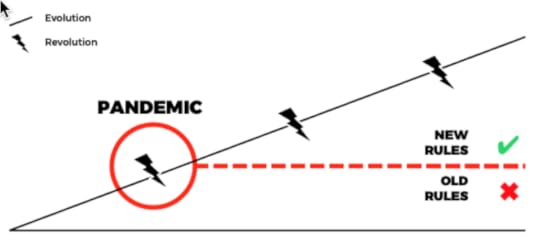
A revolutionary cycle is painful because it depends on who has the power or the insights or even the willpower to define those new rules. But to start, you have to recognize that we are in a revolutionary cycle, and you cannot do that unless you do not have legacy leadership. Leaders come in at different times and in different eras of growth, and in today’s world, you need leaders that create or meet the future. So let’s get down to what that means. Again neither is right or wrong, and you can start with one and shift to the other. The reality is 99% will meet the future, and 1% will create the future.
[image error]
Why, the willingness. To think and work on a clean slate I. Times when everyone is hanging on. To everything they got since they are worried they may lose everything that has a world so hard to obtain makes it super hard to overcome.
Are you willing to start over again ?
Are you willing to l eave everything?
Are you willing to accept new realities regardless of what they are?
Are you willing to restart over again until you start?
These questions help define what mindset we have? If you answered yes to all, you are more likely to create the future. If you answered no to one or more not to worry, you know where you stand, which is about meeting the future.
[image error]Are we stuck in recovery
We are stuck because we have been conditioned with this idea relating to a single keyword called “recovery.” — recovery is a disillusion. It assumes we will come back to where we started and continue on the path we were on initially. Does that make sense? See, we got so conditioned to find comfort in the idea of recovery that everything points us towards saving certain things we have at any cost. Does that help the future?
Recovery happens in evolutionary cycles, not in revolutionary cycles. Why, because in an evolutionary cycle, we fluctuate within a relative space better known as a correction. Why a correction? Well, it means we slightly divert off the path we have decided is the only way forward. Super comforting, isn’t it. Another dissolution because it still assumes a recovery. We are in a revolutionary cycle, and the rules are changing.
So what are those rules? — Let’s systematically challenge what those rules are.
Status quo rules
Narrow interest rules
Outdated rules
Neglected rules
Poorly designed rules
If the rules around you qualify into any of these five categories, consider how they are being changed. Look at them from these four types of possible changes taking place.
Removed and destroy
Adjusted and improve
Disrupted and change
Accelerated and adapt
Once we now see the category and its stage, we can start to tackle what is changing around us. But why change? We are in a transition process right now. The rules have not been defined yet, and this is why we are in a struggle right now.
Do not try predicting the future yet. This process is about understanding change while it is happening. This is the opportunity in itself. It allows you to be part of the change taking place. Whether your impact is small or large, it doesn’t matter. What matters right now is that you will need to change, and have a way to do that. By understanding this, you have a much tighter grip on the future vs. making a prediction and waiting for it to either happen or not.
[image error]Boardroom ego, breakthrough before it breaks you
One of the most significant factors in legacy leadership is boardroom ego. Is when everyone at the table thinks they got the answer, and no one else does.
Have you noticed that legacy thinking at the boardroom outweighs many other factors? It’s because they are scared and not thinking about the future but more about their survival. This does work. So what I have done in the past is start shaping the growth hacker mindset. The growth hacking mindset is a thought process in which all thinking and actions lean in one direction: growth and nothing else.It starts with a single statement.
“I don’t know…”
A moment of silence and a breath of fresh air, isn’t it. The weight of expertise needs to be removed. In reality, we are not being paid for our expertise; we are being paid to solve problems. The bigger the problem and the faster we can solve it, the more valuable we become.

Along the way, we forget this for two reasons, one we were never told we are problem solvers, so we don’t really embrace it. Second, we don’t solve the real problems and get distracted and unfocused. As a result, we revert from being a problem solver to a super corporate diplomat instead.
[image error]Back to mindset and making it work
Once we know that we don’t know, what’s left in front of us is a blank paper and a fresh perspective—an empty field, waiting to be shaped.
When problem-solving really starts, we start to ask the following questions, which I use to shape the growth hacking mindset.
If we have not solved it, who else has
If they solved it well enough, why are we solving it too?
If it has not been solved, why are we solving it?
If we are to solve it, what is the problem in itself?
Do we understand the problem? — If not, what do we need to do to understand this problem?
Can we solve this problem?
Is it worth it? What’s the significant outcome we want
Start at step one again and see if we land at the same spot and take a break first.
Does it stick? Verify you’re tackling the right problem.
Pinpoint your single starting point and keep it simple
This process allows us to get super-focused on what we are solving, why we are solving it, and if it is worth it. Remove legacy at all costs; it will not help you even if everything you have is riding on it. It’s dead and won’t help you and especially now.
Legacy leadership is dead what now
Let’s keep going… So once we have changed the way we think using the growth hacker mindset, we step back and ask ourselves those two strategic options
Create the future
if so, will I CREATE and get CONTRIBUTORS or
will I entirely CREATE MY OWN
Meet the future
If so, will I let OTHERS create, and I will follow or
Will I let others create and I will CONTRIBUTE
What does this entail? First off, you choose where you can best start knowing you can transition towards the future. The best place to start without much thought is the point of least resistance and work from there. Sounds pretty basic, right? Well, that is because it should be— its not rocket science.
[image error]Old Industries, fresh thinking, a whole new world
It is a reality that traditional industries will most likely have a conventional way of working. The reality check here is that even the oldest industries are being disrupted by innovators shaking that old tree up, getting all the apples out of it.
Disrupt or be disrupted; it’s that simple. Again it’s legacy leadership that keeps things sitting still. Traditional industries are no longer just old; it’s a traditional industry in a new form. What do I mean, old industries will morph into new shapes and sizes. This is why you see some of the biggest companies in trouble and many in the process of collapsing.
New organizations will emerge; they won’t replace old ones; they will disrupt and start a new evolutionary cycle. A good example is Tesla; it is in an old industry in new ways creating a whole new future. As a result, Tesla has ignited more automotive startups in the past three years than in the last 50 years combined. Size that up. Even apply this to other industries that would be classified as traditional and proof is in the pudding.
Here are ten industries impacted right now on the verge of massive changes:
Airlines
Hotels
Restaurants
Entertainment
Fashion
Transportation
Education
Personal services
Medical services
Professional services
Please don’t get bogged down in pointless details that would try to argue that this isn’t true; it’s one of those things where you either see it or not. If you’re directly or indirectly in one of these ten industries, legacy leadership will not help you. It doesn’t stop here; the longer this pandemic takes, you will see much more challenging changes.
The bigger they are, the bigger they fall.
It’s true, some will prosper significantly from this pandemic, but most of us will not. Remember, this is equivalent to a storm. A bad storm at best, but a storm is temporary; it starts, does its business, and goes away. We will see three types of organizations emerge at the end:
Old organizations who will disappear who were not able to change at all
Old organizations who were able to adapt, but eventually create the future
New organizations that have taken the places of old ones who seize to exist
There is some truth to size and agility. The bigger the organization, the bigger their buffer is, which buys them time to solve problems, but if they are stuck on legacy thinking, they will burn that buffer quickly. So size does help, but isn’t always the deciding factor of survival; it’s how you think about solving the problems ahead of you, which leads to legacy leadership that will not help you.
That said, at the cost of organizations that rely on legacy leadership, new ones will arise. The gap they will leave will be deep and prosperous but will take time. You will see the emergence of a new type of talent.
 Talent at its best
Talent at its bestThe talent pool has been decaying. It’s too easy for someone on LinkedIn or any other social network to label themselves an expert and get others to believe it. Consultants, coaches, public speakers, and influencer; the list goes on.
The noise is about to go silent when real problems emerge, and there is no more buffer, the best will naturally emerge. So for those who have suffered from over-saturated in your field, your time is coming soon. For those who have been playing the game, your time is up.
The name of the game is solving some of the world’s most challenging problems; it’s no longer exclusive to those who are among the elite of technocrats, bureaucrats, or academics. Why, many of which are still on legacy leadership, voting for a recovery, banking on their rebound. Little thought of stepping outside the boundaries of comfort and creating or adopting a new future. I don’t mean to single out or pin-down a group of people; my purpose is to highlight legacy leadership pockets and think of where it’s known to be most prominent.
That said, some amazing things will emerge from people from those spaces, but not the way they had been doing it before. Time will show us the best of them. Here are five things to do to get prepared for this talent boom:
Get fine tuned and hone in on key skills
Focus on micro-tasks that supercharge your talent
Join or build support communities focused on skill building only
Get visibility by share your strategies, and insights openly
Make what you do fun for others to absorb
Forward to basics
Finally, it’s essential to understand; we need to go back to basics. BUT here is the big secret, the direction isn’t backward, it’s forwards.
How that works exactly is like this. We need to go to the basics, but we have many tools, techniques, and technologies to accelerate and enhance the basics. So we have to hone in on essentials and keep them very focused. We are in a fascinating time in history where w have access to tools and techniques like never before.
We have to use those tools wisely; we have to start with the basics but not get blinded by sexy technologies with mostly empty promises that lead us to the same problems we are in now. Technology is designed to serve us, not the other way around.
Legacy leadership and moving forward
Legacy is a tail we can learn to be entertained with but not a way of shaping our future at this time. Those of you in this situation need to decide on creating or meeting the future. It’s not easy, it’s not comfortable, it’s not going to be painless, but it will benefit you and your organizations, and it might even save the very existence of it.
Get your copy of bestselling book
“Ready Set Growth Hack:
A beginners guide to growth hacking success”
Learn more about the author Nader Sabry
The post LEGACY LEADERSHIP IS DEAD economic reboot and post covid-19 realities appeared first on Nader Sabry.




